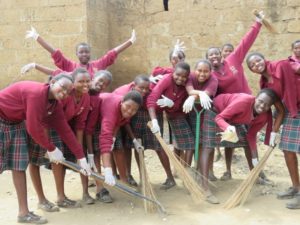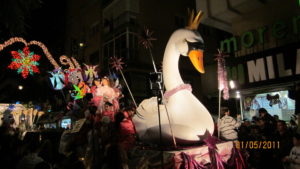During this pandemic, I miss the freedom to travel. Perhaps you do, as well, or perhaps you’re an armchair traveler. I thought I’d provide some memories of my travel adventures for this time when deciding to travel isn’t easy.
Confession—I am a travel slut. To be more formal, I’m a xenophile. If someone says, “Would you like to go to . . .” I say “When?”
I’m not quite that bad, but I do love to experience other cultures—the history, geography, architecture, people, and the food. Ah, yes, the food!
My love of travel inspired my latest mystery fiction series: Adventure Calls. The focus is on an ecotourism company called—wait for it—Adventure Calls Touring. So far, they’re keeping their trips to the southwestern United States. The first, Murder, Sonoran Style, took place southeast of Tucson and the one I’m finishing now is set in Cottonwood, Arizona. But who knows where adventure will my characters next? I welcome your suggestions!
Kenya Is So Much More Than Lions and Wildebeests!
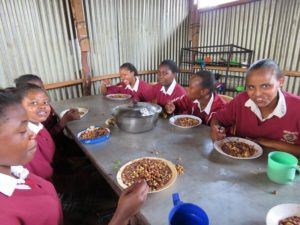
As I mentioned above, finding great food is one of my major goals when I travel. So it might surprise you that the Kenyan meals I remember with most fondness consisted of tea, bread, and on occasion, butter. I’m talking packaged white and sometimes wheat bread, not some exotic fruit or nut bread. More on that later.
My husband and I traveled to Kenya to visit Caring Hearts High School, a school for orphaned and impoverished girls started by my Boise, Idaho, friend, Vincent Kituku. Vincent left his native Kenya more than twenty-five years ago. At Caring Hearts High School, we were introduced to some remarkable young women and to the staple food of Kenya, Githeri.
I was born in Southern California and my parents were both raised there, so it makes no sense that comfort food to our family was pinto beans and ham hocks. But they were, and, I confess still are.
So it’s no surprise that I fell in love with Githeri. It’s basically a one-pot dish of boiled corn and beans, with additions when they’re available. Since the school grew their own tomatoes and collard greens, those were often added. I love it and I’ve added one recipe to my website. One evening we served the girls their Githeri and they soon let me know my servings were way too small for young women who’d been up studying since 4 a.m.!
During our time in Kenya, we stayed in the capital city of Nairobi. Each morning we were served a delicious breakfast that always included Sukuma Wiki, Kenyan Greens. While the dish is most often made with collard greens or kale, ours was made with onions and spinach. Many people have allergies to collard greens, hence their decision to serve simmered spinach. We often serve it for breakfast since our return.
Caring Hearts High School is in Tala, about a 90-minute drive from our lodging in Nairobi. A harrowing 90 minutes! Have you ever seen a freeway with a crosswalk? Visit Nairobi! People walk alongside the freeway, many balancing loaded baskets on their heads, and cross with or without designated markings. Most taxis are motorbikes, often carrying two passengers, sometimes chickens—or sheep!
You can read more about our visit and why Vincent started the school in this earlier post.
During our visit we took some side trips to small schools. No matter how impoverished the school, how fragile the building or how worn the school uniforms were, we were always welcomed with tea and snacks, usually white or wheat bread. Honored and humbled, we always partook, despite my snobbish aversion to Wonder Bread. My husband and I took as much pleasure in these snacks as we did in scones and clotted cream in New Zealand.
At every school, we were entertained—the students sang or danced or recited poetry. When we brought new uniforms to one small rural school, I was able to visit and shake hands with the children. They all wanted to shake my hand, because I was the first white woman most of them had seen. I choked back my tears and shook till my hands ached.
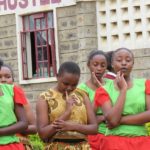
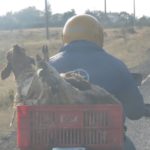
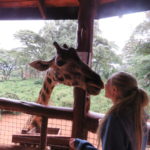
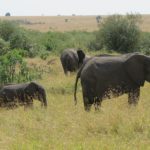
The Prize at the End of A Long, Dusty Road: Safari!
We took a break mid-visit to explore a tiny part of the Masai Mara National Reserve.
We arrived after a grueling six hour plus ride over bumpy, dusty dirt roads. On our way, we overlooked acres and acres of Kenyan black tea, the country’s major export.
As we walked to the dining room from our tent, we saw giraffes in the distance. I’d kissed a giraffe at a wildlife park in Nairobi (photo is of a young woman on our trip), but this was, finally, real. We were on a safari. Who knew what else we would see on our drive the next day? I shivered with excitement. On the drive up, we’d all shouted and pointed each time we saw a wild animal, no matter how far away it was. Vincent, our guide, only smiled. He knew what the next day would bring.
The next morning, we took off. Vans ranging from our modest open-topped vehicle to the deluxe transport provided by the most elegant and expensive safari tours, dotted the vast desert, all of us in search of animals. It surprised me that the drivers communicated via radio, and the minute one van spied “game,” many vehicles raced to that site to take a look. I’d expected more of a competitive scene, but everyone cooperated and shared what they discovered.
I crowed my joy when I saw the very first elephant of our safari. I glowed with pride until Vincent pointed out that it was a rock. Maybe I was a over-eager? He still teases me about my sighting of “Elephant Rock.”
Our vans were often able to get quite close to the animals. They knew we were there, and were wary, but were obviously accustomed to their fans.
Our only disappointment on our day-long safari was not seeing the wildebeest cross the Mara river as part of their migration. Talk about uncooperative! A herd crossed the day before and—we later learned—the day after our visit.
A Visit to a Masaai Village

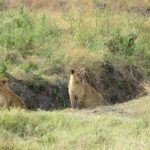

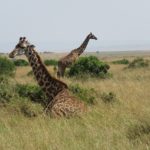
Working Together Builds Bonds
Back at Caring Hearts High School we spent time in the classrooms, worked in the garden with the girls, ate more Githeri (yay!) and one day collected garbage together in a neighboring community. The girls studied hard, worked hard, and smiled a lot. Like teens everywhere, some were shy, almost afraid to look at us, others proudly recited poetry and told us of their plans.
Many of these students, girls who had done well in lower levels of school, were orphans or lived in dire poverty, and faced early marriages, menial jobs or prostitution because they could not afford high school tuition. Admission to Caring Hearts changed the courses of their lives.
Thinking optimistically, schools like Caring Hearts are training young women to take a bigger role in their country’s economy, but the challenges are immense. Now the graduates are attending university, planning to serve their country, as teachers or medical professionals, for example. Some of the most daring even plan to enter politics, to work against the widespread institutional corruption.

Kenya Today and the Impact of COVID-19
Although the government’s strict enforcement of quarantines reduced the number of deaths caused by the COVID-19 virus, the pandemic has devastated the country’s economy. Tourism is a major contributor to the economy, and some researchers estimated a decline in international tourist arrivals of from 58% to 78% this year. **
What will happen when—not if—the world gets this virus under control is hard to predict. Tourism and agricultural exports have decreased greatly and may recover along with the global economy.
I’m hopeful the graduates of Caring Hearts High School will have a role in their country’s recovery.
In my travels with my husband, we sometimes over-indulge our zest for trying new food; on others, we get a taste for local culture. In Kenya, we had the singular opportunity to work and travel with native Kenyans. I can’t imagine a better experience. And we found Githeri and Sukuma Wiki.
What about you? Have you traveled somewhere that filled your soul, your eyes and just possibly your hopes for the world? (Or maybe just someplace fun?)
** Irandu, Prof. Evaristus M. “Impact of COVID-19 on Travel and Tourism Industry in Kenya.” Research, Innovation and Enterprise Blog, University of Nairobi, 21 May 2020, uonresearch.org/blog/impact-of-covid-19-on-travel-and-tourism-industry-in-kenya/.
